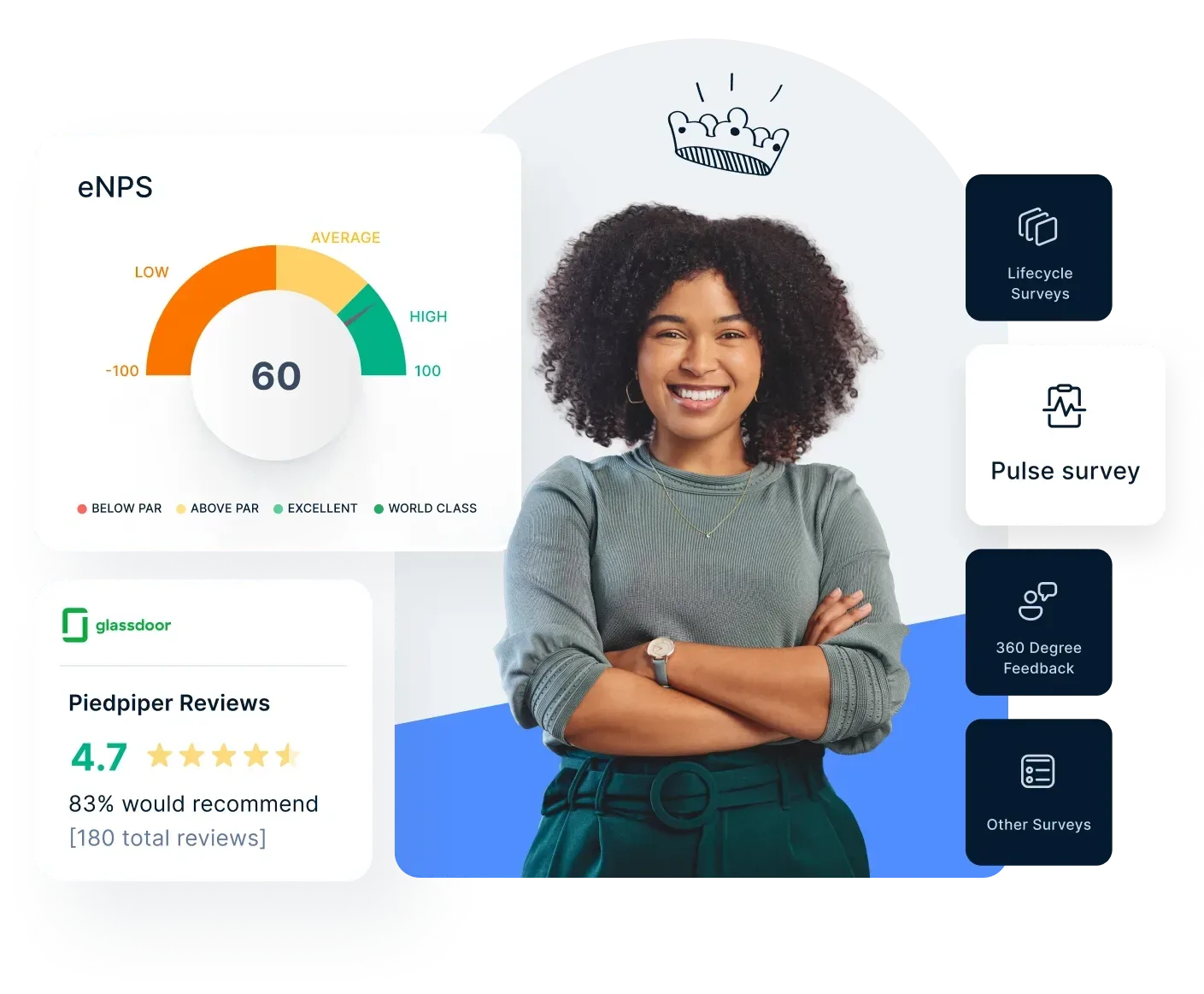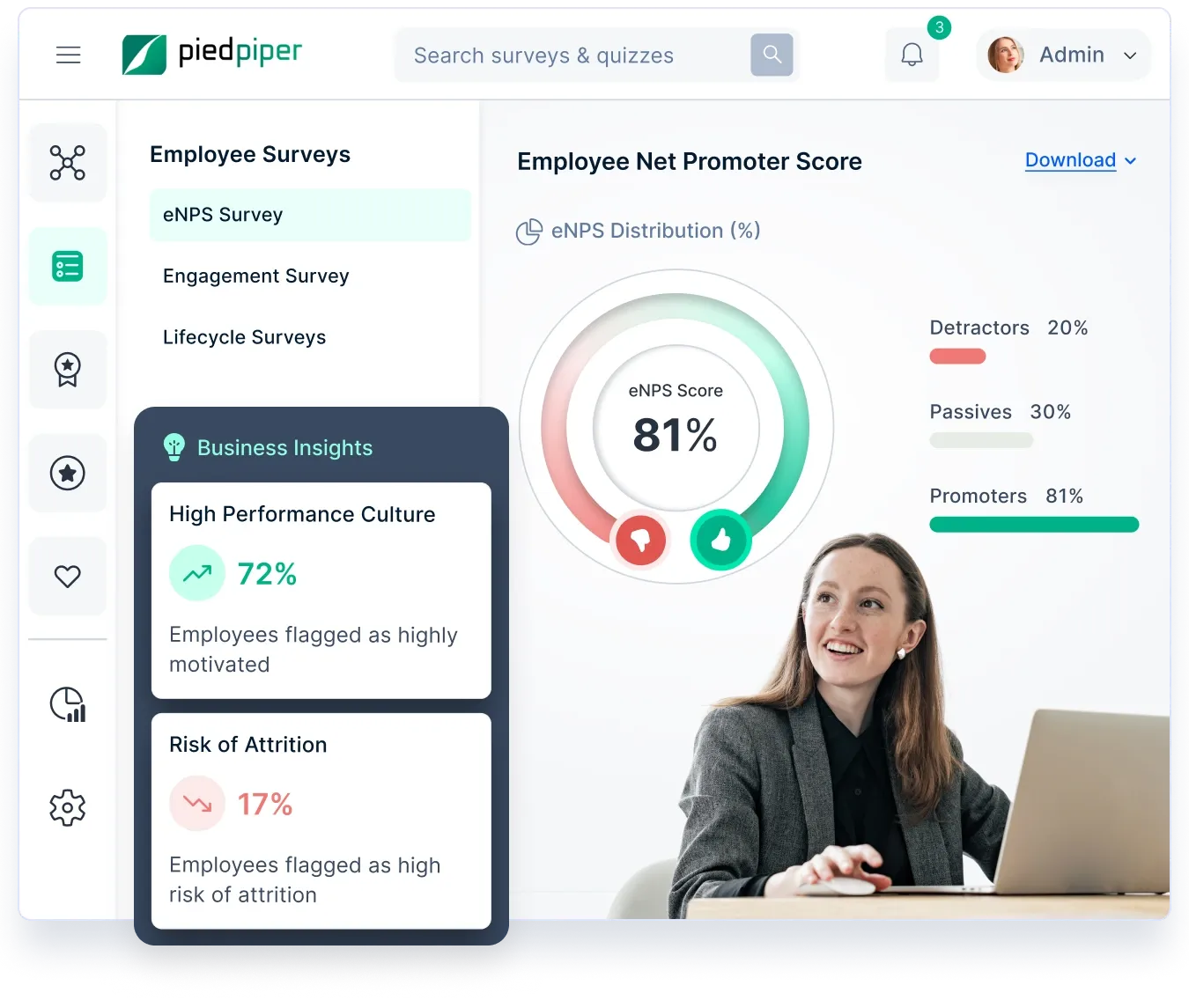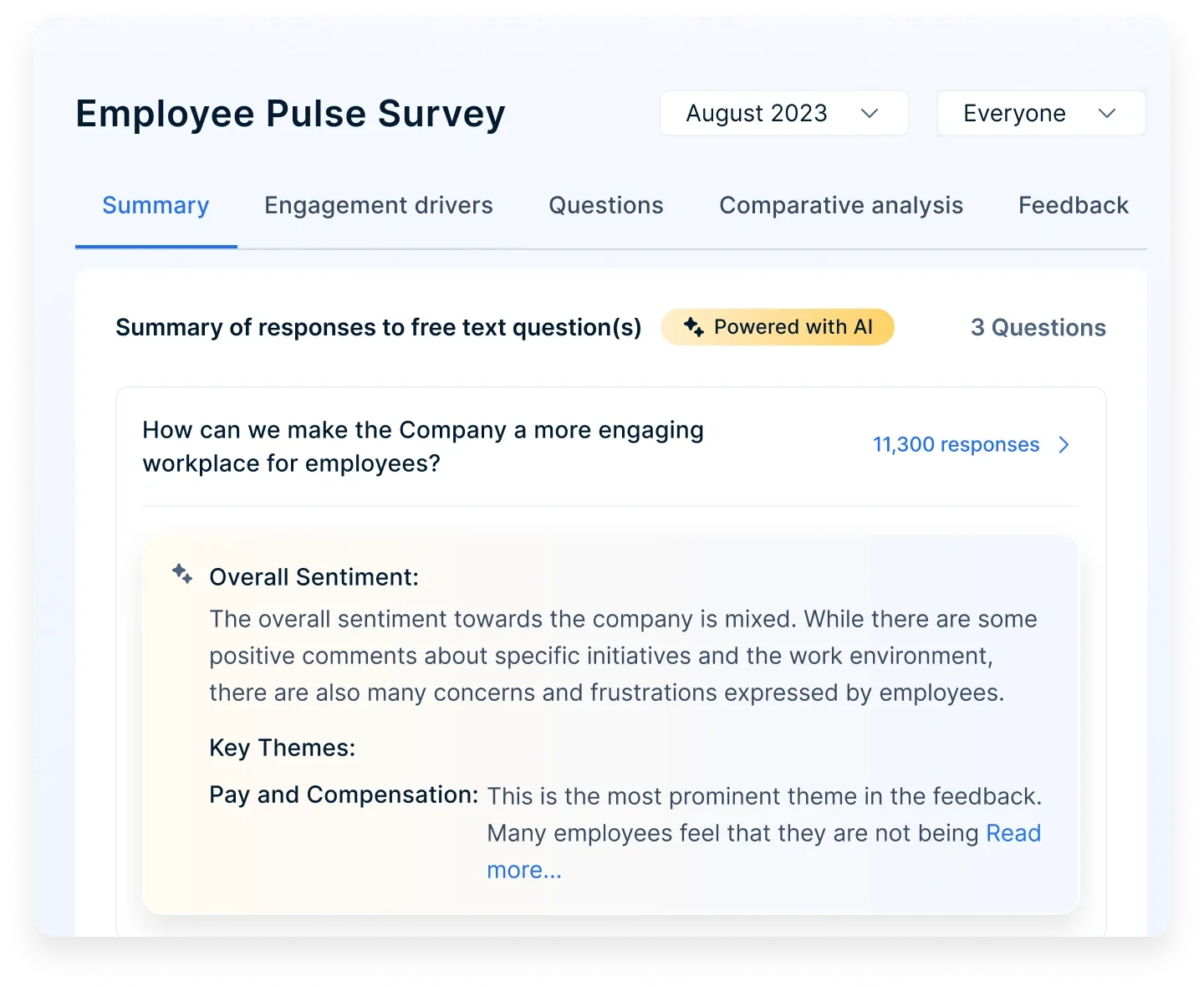Auf dieser Seite
What makes employees excited to come to work each day? It’s not just the salary or the job title—it’s the positive company culture they experience. A workplace where people feel valued, heard, and connected can make all the difference between just showing up and showing up with purpose.
But how to build a positive company culture that lasts? It starts with defining and bringing your core values to life through leadership, communication, recognition, and daily practices. A strong culture doesn’t happen accidentally—it’s intentionally created, nurtured, and evolved.
In this blog, we’ll explore what company culture means, why it matters more than ever, and actionable steps you can take to create a thriving environment where people love to work—and stay.
Was ist Unternehmenskultur?
Company culture refers to the shared values, beliefs, attitudes, and behaviors that characterize an organization and guide how employees interact with each other and customers.
A positive workplace culture that binds a company with employee satisfaction, job satisfaction, and work-life balance constitutes a value-driven company culture.
According to Gallup3, employees who feel strongly connected to their organization's culture are 3.7 times more likely to be engaged at work and 55% less likely to actively look for another job. This proves that organizations must prioritize offering their employees a value-driven company culture.
Zu den wichtigsten Aspekten der Unternehmenskultur gehören:
- Auftrag, Werte und Ziele des Unternehmens, die die Entscheidungsfindung und das Verhalten der Mitarbeiter bestimmen
- Normen, Erwartungen und ungeschriebene Regeln, die Einfluss darauf haben, wie Dinge erledigt werden
- Führungsstil und die Art und Weise, wie Führungskräfte mit ihren Mitarbeitern umgehen und sie unterstützen
- Arbeitsumfeld, Richtlinien und Leistungen, die sich auf die Zufriedenheit und Bindung der Mitarbeiter auswirken
- Traditionen, Feste und soziale Interaktionen, die das Gemeinschaftsgefühl fördern
Types of company culture
Understanding the different types of company culture can help you identify where your organization currently stands—and where it should be headed. Each type shapes employee behavior, decision-making, and overall workplace vibe in its own way. Here's a quick look at the most common ones.
1. Adhocracy-Kultur
Imagine an organization that's flexible and structured, constantly innovating while maintaining order. That's the essence of an adhocracy culture. It combines the adaptability of "ad hoc" (meaning "for this purpose") with the organization of a bureaucracy.
In einer Adhocracy wird die Kreativität nicht durch Regeln unterdrückt. Stattdessen liegt der Schwerpunkt auf der kontinuierlichen Verbesserung und der Infragestellung des Status quo.
Where can we use adhocracy culture?
This fast-paced environment is ideal for startups and tech companies like Apple, Google, and Facebook. It allows them to be nimble and keep pace in a highly competitive, ever-changing market.
Da diese Unternehmen jedoch zu Tech-Giganten heranwachsen, ist eine einzige Adhocracy für das gesamte Unternehmen möglicherweise nicht mehr tragbar. Einige Abteilungen, wie z. B. Compliance oder Ethik, benötigen möglicherweise mehr Struktur und einen langsameren, methodischeren Ansatz.
Adhocracy enables businesses to flourish in volatile settings by promoting a culture of perpetual enhancement and strategic risk-taking. As companies grow, some departments may need a more structured approach while keeping their innovative spirit.
Merkmale:
- Der Schwerpunkt liegt auf Innovation und Kreativität.
- Ermutigung zur Risikobereitschaft und zum Experimentieren.
- Fast-paced and dynamic work environment.
- Flexibilität und Anpassungsfähigkeit an Veränderungen.
Pros:
- Treibt kontinuierliche Innovation und Differenzierung voran.
- Ermutigt die Mitarbeiter, kreativ zu denken und Risiken einzugehen.
- Fördert eine Kultur der Anpassungsfähigkeit und Agilität.
Cons:
- Mögliche Unschärfe aufgrund schneller Veränderungen.
- Für Arbeitnehmer, die Stabilität bevorzugen, kann dies überfordernd sein.
2. Clan-Kultur
Clan culture at work is like a close-knit family with tight teams and a shared sense of purpose. This culture is often found in small, family-owned businesses or startups where hierarchy takes a backseat to collaboration. Employees, regardless of their position, feel valued and supported.
Beispiele für Clan-Kultur
Companies like Tom's of Maine, Redmond (Real Salt), and Chobani are prime examples of clan culture, prioritizing its employees and fostering a clan-like atmosphere.
Besonderheit der Clan-Kultur
- Teamarbeit ist das Rückgrat dieser Kultur, in der sich jeder wohl fühlt, wenn er Ideen und ehrliches Feedback austauschen kann.
- Auch Mentorenschaft und Ausbildung spielen oft eine wichtige Rolle, um sicherzustellen, dass Fähigkeiten und Werte organisch weitergegeben werden.
- Eine der größten Stärken einer Clan-Kultur ist das hohe Engagement der Mitarbeiter, das sich in einem hervorragenden Kundenservice niederschlagen kann.
Merkmale:
- Offene und informelle Kommunikation.
- Unterstützendes Arbeitsumfeld.
- Flache Organisationsstruktur mit minimaler Hierarchie.
- Starke Beziehungen zwischen den Mitarbeitern.
Pros:
- Ermutigt zu offenem Feedback und Kommunikation.
- Fördert gute Beziehungen zwischen den Mitarbeitern.
- Fördert ein Gefühl der Zugehörigkeit und Einheit.
Cons:
- Kann zu einem Mangel an Förmlichkeit bei geschäftlichen Kontakten führen.
- Gefahr, dass die Mitarbeiter zu entspannt an ihre Arbeit herangehen.
- Die Aufrechterhaltung eines engmaschigen dynamischen Umfelds kann eine Herausforderung sein. Eine Ausweitung der Aktivitäten kann zu einem Verlust an Fokus und Flexibilität führen.
3. Kultur der Hierarchie
Hierarchy culture is a type of organizational culture that strongly emphasizes structure, order, and rules. In this culture, the organization is structured hierarchically, with a detailed hierarchy system that defines job titles, roles, and levels.
Employees are expected to follow the rules and procedures set by upper management, with a top-down flow of information and communication. This culture thrives on transparent chains of command, established procedures, and well-defined roles. Everyone knows who they report to, who they manage, and the rules that govern their work. Following these rules and doing things the right way is paramount.
Herausforderungen in der Hierarchiekultur
- Hierarchy cultures might struggle to adapt quickly to changing markets or innovate rapidly.
- The emphasis on established procedures can stifle creativity and responsiveness in a world increasingly demanding agility.
Vorteile der Hierarchiekultur
- Hierarchy cultures excel at streamlining operations and clearly defining duties. This makes them a natural fit for finance, healthcare insurance, and oil and gas industries, where stability and risk management are crucial.
- Klare Strukturen ermöglichen es diesen Unternehmen, effizient zu arbeiten und komplexe Prozesse effektiv zu bewältigen.
Nachteile der Hierarchiekultur
- Inflexibility and resistance to change
- Barriers to communication
- Lack of creativity
Während die Hierarchie Stabilität bietet, müssen Unternehmen in dieser Kultur möglicherweise Wege finden, kalkulierte Risiken einzugehen und ein gewisses Maß an Anpassungsfähigkeit zu fördern, um langfristig wettbewerbsfähig zu bleiben.
4. Marktkultur
In market cultures, the game is all about winning. Companies here are laser-focused on maximizing profits and staying ahead of the pack. They prioritize results and watch the competition, constantly striving to deliver products and services that keep customers coming back for more.
Beispiele für Marktkultur
- Tesla
- General Electric
- Amazon
Für diese Unternehmen ist Innovation das Lebenselixier. Sie brauchen einen ständigen Strom erstklassiger Produkte und Dienstleistungen, um ihren Vorsprung zu halten. Dieser ständige Drang nach Spitzenleistungen kann die Kreativität fördern und zu bahnbrechenden Fortschritten führen.
Der Druck kann jedoch immens sein. Mitarbeiter in Marktkulturen sind oft mit hohen Erwartungen und unerbittlichen Produktivitätsanforderungen konfrontiert. Dies fördert zwar den Geschäftserfolg, kann aber auch zu Burnout und einer Vernachlässigung des Wohlbefindens der Mitarbeiter führen.
The challenge for market cultures lies in striking a balance. They must maintain their competitive edge while fostering an environment that supports and motivates their workforce.
Merkmale:
- Der Schwerpunkt liegt auf der Erzielung von Ergebnissen und der Einhaltung von Zielen.
- Ein wettbewerbsfähiges Arbeitsumfeld.
- Hohe Leistungserwartungen.
- Konzentration auf Effizienz und Produktivität.
Pros:
- Fördert Leistung und Zielerreichung.
- Ermutigt zu einer ergebnisorientierten Denkweise.
- Fördert den Sinn für Dringlichkeit und Verantwortlichkeit.
Cons:
- Gefahr der Förderung eines Verdrängungswettbewerbs.
- Burnout-Potenzial aufgrund einer Arbeitskultur, die von hohem Druck geprägt ist.
Why is positive company culture important?
Die Unternehmenskultur spielt eine entscheidende Rolle für den Erfolg und das Wohlbefinden eines Unternehmens und seiner Mitarbeiter. Hier ist eine Aufschlüsselung, warum sie so wichtig ist:
1. Attracting and retaining top talent
Die Gewinnung und Bindung von Spitzenkräften ist einer der wichtigsten Aspekte beim Aufbau einer starken und positiven Unternehmenskultur.
- Employer branding: A strong culture attracts qualified candidates who identify with the company's values and mission. It creates a positive reputation in the job market, making the company more attractive to potential hires.
- Employee satisfaction: People are likelier to stay with a company where they feel valued, respected, and belonging. A positive culture fosters job satisfaction and reduces turnover rates, saving the company time and money on recruitment.
2. Boosting productivity and performance
Employees’ performance and productivity tend to rise when an organization prioritizes building a positive company culture.
- Motivation and engagement: Employees who feel connected to the company's goals and share its values are more likely to be motivated and engaged in their work. This translates to higher productivity, better problem-solving, and a drive for excellence.
- Kollaboration und Teamarbeit: Eine starke Kultur betont Zusammenarbeit und Teamwork, was zu besserer Kommunikation, Wissensaustausch und Innovation führen kann. Die Mitarbeiter sind eher bereit, sich gegenseitig zu helfen und auf gemeinsame Ziele hinzuarbeiten.
3. Enhancing customer experience
- Employee happiness: Happy and engaged employees provide better customer service. A positive culture translates to a more positive and helpful attitude toward customers, ultimately leading to higher customer satisfaction and loyalty.
- Brand advocacy: Employees who believe in the company's mission and values become brand advocates. They're more likely to go the extra mile for customers and promote the company positively.
4. Overall business success
- Geringere Kosten: Eine geringere Mitarbeiterfluktuation, eine höhere Produktivität und ein positiver Ruf der Marke tragen alle zum Endergebnis eines Unternehmens bei. Eine starke Kultur kann zu erheblichen Kosteneinsparungen und einer besseren finanziellen Leistung führen.
- Anpassungsfähigkeit und Innovation: Eine Kultur, die zu offener Kommunikation ermutigt, neue Ideen aufgreift und die Bereitschaft zum Lernen fördert, kann einem Unternehmen helfen, sich an Veränderungen anzupassen und auf einem wettbewerbsorientierten Markt die Nase vorn zu haben.
Wie man eine positive Unternehmenskultur aufbaut
Building a positive company culture is about intentionally creating an environment where employees feel valued, connected, and inspired to do their best work. It’s more than perks—it's about purpose, people, and practices that shape everyday experiences.
Here’s a comprehensive guide on how to build a positive company culture:
1. Define and live your core values
Your company values should be more than words on a wall—they should shape your decision-making, influence your behavior, and guide your company’s growth. Articulated values help employees align their efforts with a common purpose, creating unity and direction.
Tips to implement:
- Co-create values with input from employees for authenticity.
- Incorporate them into hiring, onboarding, and goal-setting processes.
- Use them to guide recognition programs and performance feedback.
2. Foster open and transparent communication
A transparent culture builds trust, reduces misunderstandings, and encourages collaboration. Employees who feel informed and heard are more likely to engage and contribute meaningfully.
Tips to implement:
- Hold regular team meetings and town halls to share updates.
- Encourage two-way feedback through surveys and 1:1 check-ins.
- Use digital platforms to create a space for continuous dialogue.
3. Recognize and reward your employees
Appreciation fuels engagement. When recognition is regular and sincere, it reinforces positive behavior and motivates employees to do their best work.
Tips to implement:
- Set up peer-to-peer recognition programs.
- Celebrate small wins, not just major milestones.
- Align rewards with values to highlight what matters most.
4. Promote inclusivity and belonging
A strong culture includes everyone—regardless of background, identity, or role. Employees who feel accepted and valued are more likely to stay, grow, and advocate for the organization.
Tips to implement:
- Provide DEI training and inclusive policies.
- Recognize diverse cultural events and identities.
- Facilitate safe, open discussions on inclusivity and fairness.
5. Support growth and development
Employees thrive in environments where they can grow. Providing career development opportunities shows you’re invested in their long-term success and helps retain top talent.
Tips to implement:
- Offer upskilling and mentorship programs.
- Create individual development plans and internal mobility paths.
- Encourage knowledge sharing and cross-functional projects.
6. Encourage work-life balance and well-being
A culture that values well-being leads to healthier, more productive employees. Empower your people to take care of themselves without guilt.
Tips to implement:
- Offer flexible work arrangements and mental health resources.
- Encourage time off and discourage working beyond hours.
- Introduce wellness perks like travel vouchers, fitness stipends, or mindfulness sessions.
7. Measure and improve continuously
A healthy culture is always evolving. Regularly checking in with employees ensures that your initiatives stay relevant and practical.
Tips to implement:
- Run engagement surveys and act on feedback.
- Track participation in programs and events.
- Use analytics to identify cultural strengths and gaps.
How Empuls helps build a positive company culture that lasts
Positive company culture isn’t built overnight—and it doesn’t happen by accident. It takes consistency, recognition, transparency, and a genuine commitment to employee well-being. That’s exactly what Empuls delivers.

Empuls is an all-in-one employee engagement and culture platform designed to help HR and leadership teams shape a thriving culture—where people feel connected, valued, and aligned with the company’s mission. Whether your workforce is remote, hybrid, or spread globally, Empuls brings everyone together on a single platform that powers everyday engagement.
Here’s how Empuls helps you build culture with intent and impact:
⭐ Make recognition a daily habit
Move beyond once-a-year awards. Empuls makes it effortless to recognize employees in real-time—with peer-to-peer recognition, spot bonuses, and automated milestone celebrations. When employees feel appreciated consistently, they stay motivated and committed.

💬 Strengthen employee connection
Empuls acts as your internal social hub—empowering employees to communicate openly, celebrate team wins, and build a sense of belonging through a social intranet. Whether it’s a remote shout-out or a team-wide update, everyone stays in the loop and involved.

🧭 Embed values into daily actions
Link recognition and rewards to your core company values to reinforce what matters most. This creates behavioral alignment, builds purpose, and helps every employee see how their contributions tie into your larger mission.

📢 Give employees a voice that drives change
Empuls makes it easy to run pulse surveys, eNPS, and lifecycle feedback—capturing real-time insights into how employees feel. You can act fast, close feedback loops, and ensure your culture evolves in step with your people.

📊 Turn data into decisions
With built-in engagement analytics, you’ll never have to guess what’s working. Track recognition frequency, feedback participation, and engagement trends to make smarter, people-first decisions that boost culture from the inside out.

Empuls helps you turn culture into a strategic advantage—by making recognition, feedback, and connection part of your everyday workflow. Whether you're a growing startup or an enterprise leader, Empuls is the culture engine that drives sustainable engagement.
Start your free trial or book a demo with Empuls today and take the first step toward a more positive, engaged, and thriving organization.
Schlussfolgerung
Developing a positive company culture re-structures an organization to provide an eco space where employees are valued and cared for. A company must foster clear communication of values, consistent leadership, and an inclusive environment.
Zur Bewertung der Unternehmenskultur gehören regelmäßiges Feedback, die Messung der Übereinstimmung mit den Grundwerten und die Analyse der Auswirkungen auf die Zufriedenheit und Leistung der Mitarbeiter.
Organizations can create a thriving workplace where employees feel valued and motivated by prioritizing company culture. This, in turn, translates to a competitive advantage, as a positive culture attracts top talent, reduces turnover, and drives long-term success.
Ganz gleich, ob Sie gerade erst mit dem Aufbau Ihrer Unternehmenskultur beginnen oder sie verfeinern und stärken wollen, denken Sie daran, dass Kultur eine fortlaufende Entwicklung ist, die sich mit Ihrem Unternehmen weiterentwickelt. Nehmen Sie sie an, pflegen Sie sie, und beobachten Sie, wie Ihr Unternehmen aufblüht.













